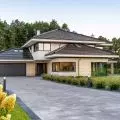The article is from A&B issue 03|23
Concrete vs greenery. Is it worth fighting for every tree in the city?
greenery - a multi-billion dollar asset
Would it make sense to trash a piggy bank stuffed with bills? Or would denying the opportunity to pay lower bills be considered reasonable? No. Then let's stop cutting down trees in our localities and start greening them.
When I was still working for a local newspaper in Lodz, a reader called me. He asked us to raise the alarm and write about more trees being cut down in the city center. "When I saw from my windows how they were getting on with the cutting, it felt like someone had cut off my leg," the man said in a worried voice. The article was written moments later. All the trees slated for removal were soon gone anyway.
I have processed many similar stories. The topic on which we received the most calls and emails from concerned readers was the environment. More specifically, trees and greenery. The same is true now that I am operating independently. Although I write about nature in a local context very occasionally, at least three quarters of the requests I receive for help in "publicizing the issue" concern the rugging of greenery.
A pedunculate oak tree growing in the Praga-Północ district, which provides ecosystem services worth more than PLN 60,000 each year.
photo: Szymon Bujalski
I think that few urban problems move as many people as the planned cutting down of trees and the creation of more concrete spaces. This doesn't mean, of course, that everyone wants to defend nature in the city - I also know of a case where, in a public consultation, the majority of residents of one street voted in favor of cutting down trees. The most common argument? Leaves falling on parked cars. Such stories, however, are in the vast minority. Most prove that greenery has been appreciated by residents.
Despite this, trees continue to disappear on a large scale, most often falling victim to the decisions of either a public authority or a developer. In doing so, in a way we actually cut our own leg, as we significantly weaken the efficiency of the urban organism. In the end, we pay for it not only with our health, but also with our wallets.
The most expensive and largest tree planted as part of the greening of Lodz's Stare Polesie housing estate; costing PLN 20,000, the linden tree at the time of planting had a girth of 100 cm
photo: Anna Perlanskaya
trees worth billions
A few years ago, researchers calculated that more than three hundred street trees growing in parts of Warsaw's Praga-Północ district bring benefits amounting to nearly PLN 2.7 million a year. If this average was translated to all the trees in the district, the so-called ecosystem services they perform would be worth 104 million. Although an estimate for all of Warsaw has not been made, it is known that it would be in the billions. And we are still only talking about street trees.
"It seems like a huge amount. However, we must realize that street-side trees, as well as trees with other functions within the city (park trees, neighborhood trees, etc.), are a valuable legacy in which previously incurred social expenditures and the value added by the forces of nature are accumulated." - explained in the publication "Trees. Green capital of cities" by Prof. Halina Szczepanowska and Dr. Marek Sitarski. Therefore, according to them, trees should be considered "public assets of high value."
Are trees in Warsaw worth fat billions? I realize that this is hard to believe. However, equally improbable valuations appear in other cities as well. For example, the value of Berlin's 400,000 street trees was estimated at 3 billion euros, and the nearly 600,000 trees growing along the streets of New York were valued at $2.3 billion.
A several-meter-high tree planted in the same Lodz neighborhood; also impressive, but not so much anymore
photo: Anna Perlanskaya
tree, service provider
How is it possible that trees are worth so much? The answer is simple: because they give us so much. At least dozens of their ecosystem services can be listed. These include lowering temperatures, transpiring water, collecting rainwater, pollutants and carbon dioxide, and protecting us from wind. This benefits not only people, but also urban infrastructure.
A study showed that in Athens, the shade of trees lowered the ambient temperature by as much as 5-7 degrees Celsius, reducing energy demand in nearby homes by 10 percent during peak hours. In New York, meanwhile, it was studied that street-side trees were more effective at reducing the heat island than white-painted roof surfaces and planting. "Trees are much more effective at lowering summer temperatures than a tent or umbrella covering the same area," they say. - Szczepanowska and Sitarski note. California, on the other hand, has found that saving energy by greening cities is often more cost-effective than... building new energy plants. Meanwhile, in the aforementioned district of Prague-North, it was calculated that, on average, one street-side tree saved 79 zlotys a year on heating and cooling bills.
It is worth bearing in mind, however, that a tree is unequal to a tree, and the benefits of the largest ones are definitely greater. Praga-North can again be cited as an example. The average value of the benefits of a tree growing by the street was estimated at 8663 zlotys per year. For small trees, however, it was "only" 3163 zlotys. For the most impressive pedunculate oak with a trunk circumference of 325 centimeters, which grows next to Solidarności Avenue - 61772 zlotys. That is, twenty times more.
something is changing?
for comparison - a tiny tree planted in the same Lodz housing estate and at a similar time
photo: Anna Perlanskaya
In recent years, the Internet has been circulating photos of markets and squares in many towns and cities that have been turned into pans. The list of cities where trees in the most representative spaces have been cut down would probably have dozens of entries. However, a trend has been noticeable for some time.
Warsaw, Krakow, Lodz, Kielce, Wloclawek, Kalisz, Rybnik, Elblag, Ostrowiec Swietokrzyski, Gorzow Wielkopolski, Ciechanow, Skierniewice... These are just some of the cities whose squares and markets have been provided for trees and low greenery. Some of the projects have already been implemented, others are in the pipeline or will soon be. Some of the changes are proposals of the local government, others are the result of winning applications in the civic budget.
And one of the main reasons for the "revitalization" so far should not be forgotten: money from the European Union. Here, too, however, a change is taking place. "Taking into account this financial perspective, EU funds will not support climate-unfriendly revitalizations of Polish cities and towns," the European Commission announced in the middle of last year, when photos of another "revitalized" space circulated on the Internet.
Of course, new trees will not replace old ones, and it is the protection of the latter that must be paramount. In addition, often the quality of the implementation of investments significantly deviates (on the downside) from that announced. And finally, cutting down trees to replant them after a few or a dozen years is a waste of public money. For these and many other reasons, it is worth exercising restraint. But it's also worth bearing in mind that, whether we like it or not, change is a process. For it to proceed for the benefit of the trees and the general public, it will take much more than greening up places that have recently been concreted over.
The tree-filled garden of the Warsaw University Library is a place frequently visited by both residents and tourists
photo: Anna Perlańska
nature is infrastructure
Above all, we need a solid law and its enforcement. Developers must not be allowed to develop valuable natural areas, tree cutting should cost them dearly, and inspections by officials should take place regularly. It is also important to create local zoning plans that will protect more plots of land from development. Limiting urban sprawl should also be a cornerstone for any local government. Investors and public entities should also be required to provide plenty of biologically active space - not in the form of banal, shaved lawn, but other forms, such as flower meadows and rain gardens.
In short: preserving what is already there and valuable should be a priority. The biggest help in embarking on this very different path from the previous one is to realize how bad the previous one was. Nature is not a problem for infrastructure - it's an infrastructural solution.






























